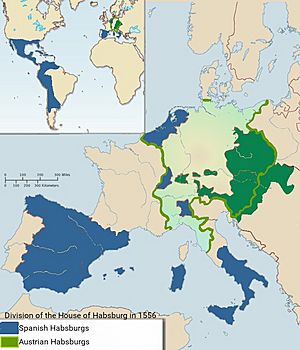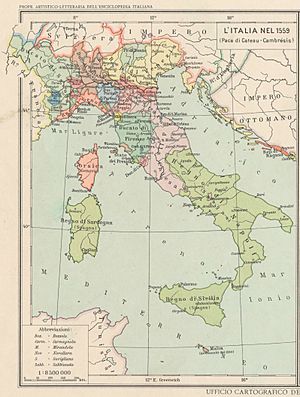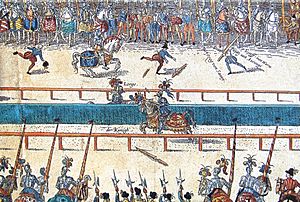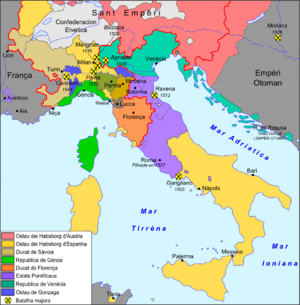Treaty of Cateau-Cambrésis (1559) facts for kids
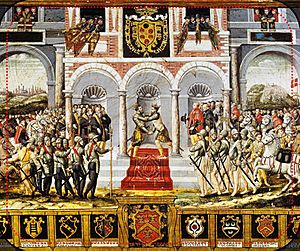
Signing of the Treaty of Cateau-Cambrésis; Henry II of France and Philip II of Spain in centre
|
|
| Signed | 2 April 1559 (England and France) 3 April 1559 (France and Spain) |
|---|---|
| Location | Le Cateau |
| Original signatories |
|
| Parties | |
| Languages | French |
The Treaty of Cateau-Cambrésis was a very important peace agreement signed in April 1559. It officially ended the Italian War of 1551–1559, which was the last part of a long series of conflicts called the Italian Wars (1494–1559).
This treaty was actually made up of several smaller agreements. The two main ones were signed on April 2nd by Elizabeth I of England and Henry II of France, and on April 3rd between Henry II and Philip II of Spain. Even though he didn't sign it, Emperor Ferdinand I approved the agreements. This was important because many of the land changes involved areas that were part of the Holy Roman Empire.
After the treaty, Habsburg Spain gained control over a large part of Italy. This included the southern kingdoms of Naples, Sicily, and Sardinia, as well as the Duchy of Milan in the north. Spain kept these lands for a long time. Meanwhile, France made its borders stronger in the south and east. France also got to keep Calais, a port city it had taken from England. In return, France gave up its claim to the Duchy of Milan. It also agreed to make Savoy an independent state again and returned Corsica to the Republic of Genoa. The treaty also officially recognized Elizabeth I as the queen of England.
Contents
Why Was the Treaty Needed?
The Italian Wars were long conflicts between France and the Habsburg Empire. They started in 1494 and lasted for over 60 years, with some breaks. For much of this time, both Spain and the Holy Roman Empire were ruled by Emperor Charles V.
The Habsburg Empire Splits
In January 1556, Emperor Charles V decided to give up his power. He divided his lands between his brother and his son. His brother, Ferdinand, received the lands of the Habsburg monarchy, often called "Austria." Ferdinand also became the Holy Roman Emperor.
Charles V's son, Philip II of Spain, was already ruler of the Spanish Netherlands and Milan. He was also a joint ruler of England because he was married to Mary I. After his father stepped down, Philip became king of Spain, Naples, Sicily, and Spain's lands in South America.
This division made it easier for France to consider peace talks. A truce was made in 1556, but it didn't last long. The war started again, and both sides faced money problems and religious issues. This forced them to seek peace in 1559.
The split of the Habsburg lands also showed different goals. Spain was a global sea power. The Austrian Habsburgs focused on being strong in Germany and dealing with the Ottoman Empire. They also had different ways of handling the Reformation and the rise of Protestantism. Ferdinand tried to find a middle ground with Protestants in Germany. But Charles V and Philip II tried to stop the spread of Calvinism in the Spanish Netherlands. This policy later led to the Dutch War of Independence in 1568.
Spain and Austria still worked together when their goals matched. The Spanish army often used German soldiers. However, Ferdinand focused on his empire and the Ottomans. Philip continued fighting, but victories at St Quentin in 1557 and Gravelines in 1558 put him in a strong position to negotiate. Like his enemies, Philip was running out of money to pay for the war.
France and England's Challenges
Henry II of France also had money problems, which made him want peace. France was surrounded by Habsburg lands on three sides. France wanted to make its borders stronger and weaken its enemies. It had achieved this by taking the Three Bishoprics in 1552 and Calais in January 1558. Dividing the Habsburg lands also helped weaken them.
France also had internal problems because of the rise of Protestantism in France. This led to disagreements among nobles and eventually to the French Wars of Religion in 1562.
England also wanted the war to end. England had joined the war as an ally of Spain. Many people saw this as a bad decision. Losing Calais, which England had held for over 200 years, greatly hurt England's reputation. It also meant England lost a key place that allowed its troops to easily enter mainland Europe.
How the Peace Talks Happened
Peace talks between France and Spain started as early as 1554. The first serious talks were held in June 1555 in Marck, which was neutral English land. But these talks failed. Both kings wanted revenge, but their armies and money were exhausted.
A truce was agreed in 1556, but it was broken soon after. War started again in September 1556. Spain won a big victory at the Battle of St. Quentin (1557) in August 1557. England had joined Spain's side, and France lost many allies. However, Henry II surprised everyone by taking Calais in January 1558. He also arranged a marriage between Mary, Queen of Scots and his son Francis. This helped Henry save face and get a better position for negotiations.
Later Negotiations
Peace talks continued in 1558. Little progress was made because France refused to give Calais back to England. Also, England found it hard to negotiate separately because Queen Mary was married to Philip II of Spain.
The final rounds of peace talks began in October 1558 at Cercamp. They then moved to Le Cateau-Cambrésis in February 1559. Important people involved in the talks included:
- Christina of Denmark (who led the talks)
- Antoine Perrenot de Granvelle (chief Spanish negotiator)
- Anne de Montmorency (chief French negotiator)
- Henry Fitzalan, 12th Earl of Arundel (chief English negotiator)

The main issues to solve were:
- What would happen to Calais (owned by England, but taken by France).
- The future of lands in northwest Italy (like Piedmont and Milan).
- Returning places in Picardy (like St. Quentin) that Spain had taken from France.
England's Role Changes
Queen Mary of England died in November 1558. Her Protestant half-sister, Elizabeth I of England, became queen. This changed things for England and France. The new English government needed peace and stability more than Calais. France had an advantage because Mary, Queen of Scots, who was Catholic and married to the future Francis II of France, also had a claim to the English throne.
This opened the door for England and France to make a separate peace. Elizabeth still wanted Calais back, but she couldn't afford to keep fighting just for that. France knew this.
Philip II of Spain knew what was happening in the talks. Even though he didn't like Elizabeth's religion, he knew that Mary, who was half-French, on the English throne would be worse. It was important for Spain not to be left out of the peace deal, especially since Philip was in a terrible financial situation. England played an important role in the negotiations, as did Emperor Ferdinand, whose approval was needed for land changes in the Holy Roman Empire. A first peace treaty between France, Scotland, and England was agreed on March 12, 1559.
What the Treaty Said
The Treaty of Cateau-Cambrésis included several agreements. The main ones were:
- April 2, 1559: Treaty between Queen Elizabeth I of England and King Henry II of France.
- April 3, 1559: Treaty between King Henry II of France and King Philip II of Spain.
Agreement Between France and Spain
- Henry II of France recognized Philip II of Spain as the ruler of Milan and Naples. France gave up its old claims to the Duchy of Milan. It also recognized Spain's control over the Kingdom of Naples, Kingdom of Sicily, and the Kingdom of Sardinia.
- Both Henry and Philip agreed to work towards a "holy universal council." This council would help reform the Christian Church and bring it together.
- Spain returned Saint Quentin, Ham, Le Catelet, and other places in northern France that it had taken during the war.
- France returned the island of Corsica to the Republic of Genoa.
- France recognized that the Republic of Florence had taken over the Republic of Siena. France also gave the Presidi to Philip of Spain.
- As part of the peace, Emmanuel Philibert, Duke of Savoy married Henry's sister, Margaret of France, Duchess of Berry. Henry's eldest daughter, Elisabeth of Valois, became Philip's third wife.
- France left Piedmont and gave the Duchy of Savoy back to Emmanuel Philibert, Duke of Savoy. Emmanuel Philibert agreed to stay neutral in future conflicts.
- France kept five fortresses in northern Italy: near Turin, Cherasco, Pinerolo, Chivasso, and Villanova d'Asti.
- France also kept the Three Bishoprics of Toul, Metz, and Verdun. These had been given to Henry in 1552.
Agreement Between England and France
- England officially gave France possession of Calais. France had taken Calais from England in 1558. This was a way for England to save face. Even though Elizabeth tried to get it back later, Calais remained French.
What Happened After the Treaty?
Celebrations and Tragedy
To celebrate the peace, a big tournament was held on July 1st. During a jousting match, King Henry II of France was badly injured. A piece of a broken lance from Gabriel Montgomery went into his eye and brain. He died ten days later, on July 10, 1559.
His 15-year-old son, Francis II, became king. But Francis also died in December 1560 and was replaced by his 10-year-old brother, Charles. This created a lot of political problems in France. Also, thousands of soldiers who had not been paid were suddenly out of work. These issues led to the start of the French Wars of Religion in 1562, which lasted for 30 years.
Changes in Lands and Power
The treaties meant that France stopped its military actions in the Spanish Netherlands and northern Italy. France also ended most of its control in Corsica, Tuscany, and Piedmont. In return, England and the Habsburgs stopped fighting France over Calais, the Three Bishoprics, and some fortresses.
For Spain, the peace was a good outcome. It confirmed Spain's control over the Habsburg Netherlands, the Duchy of Milan, and the Kingdoms of Sardinia, Naples, and Sicily. Ferdinand I allowed France to keep the Three Bishoprics. But the Netherlands and most of northern Italy remained part of the Holy Roman Empire. The Pope also recognized Ferdinand as the Holy Roman Emperor, which he had refused to do while the war continued.
England did not do well in the war. Losing Calais, its last stronghold on the European continent, hurt its reputation.
After the conflict, Italy was divided. The southern parts were ruled by the Spanish Habsburgs. The northern parts were formal territories of the Austrian Habsburgs. This situation lasted until the 1700s. The Treaty of Cateau-Cambrésis brought a long period of peace and economic stability to Italy. Some historians say this treaty marked the end of the Italian Renaissance and the beginning of the Baroque period.
Religion and the Treaty
Some historians used to think that the treaty required all rulers to force their subjects to become Catholic. For example, it was said that Emmanuel Philibert, Duke of Savoy issued an order in 1560 banning Protestantism. This led to a revolt by Protestants in his area.
However, modern historians have different ideas about why Philip II of Spain and Henry II of France signed this treaty. While Henry II did say that fighting against heresy (Protestantism) needed all his strength, many historians now believe that money problems were the main reason for the peace.
Some people at the time thought the treaty created a united front between France and Spain against Protestantism. But looking at how the talks happened, this doesn't seem to be the case. The treaty's main goal was to affirm the honor and friendship of the rulers, which was sealed by royal marriages. There is no clear proof of a Catholic alliance between France and Spain to get rid of Protestantism.
See also
 In Spanish: Paz de Cateau-Cambrésis para niños
In Spanish: Paz de Cateau-Cambrésis para niños


